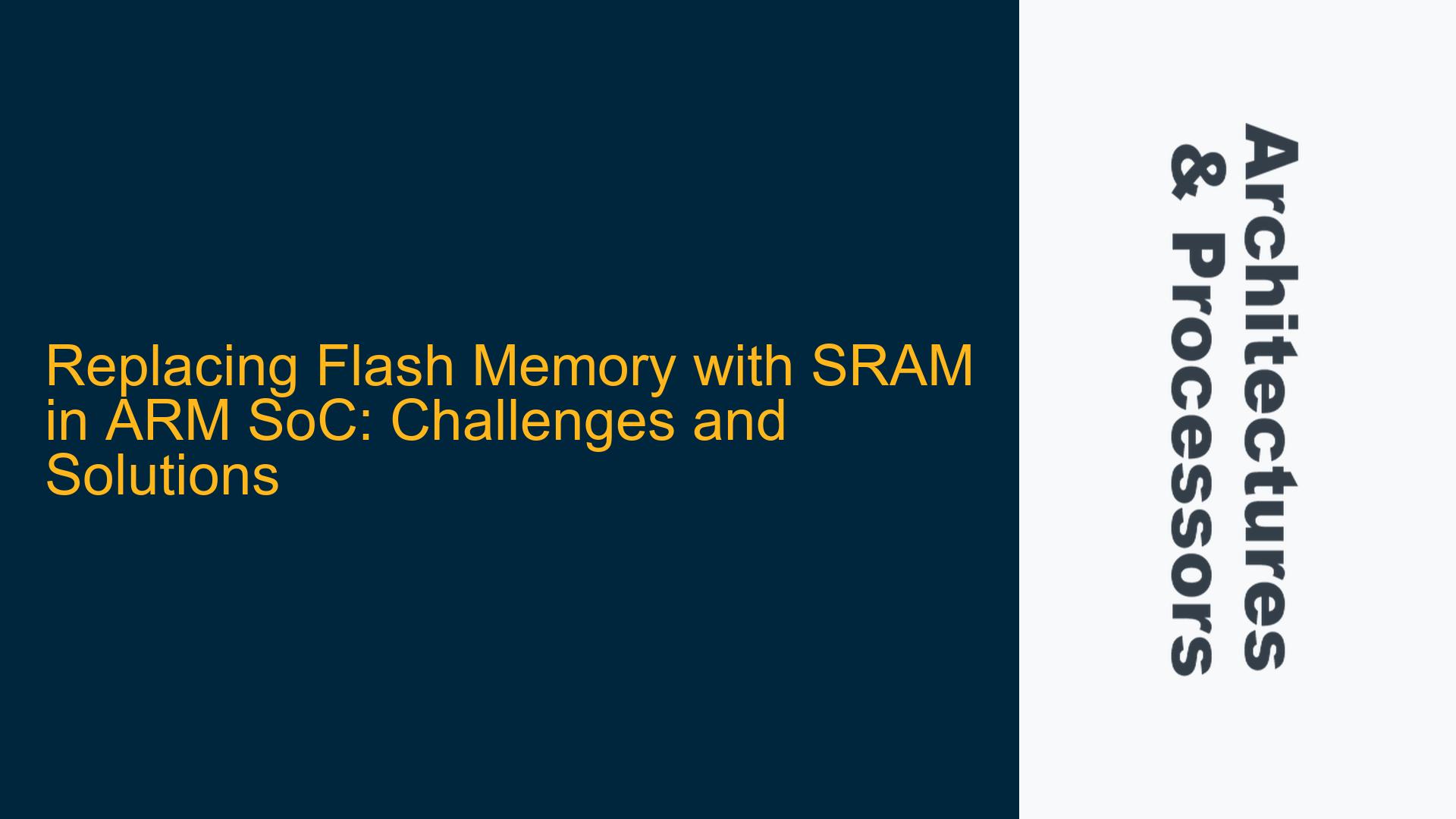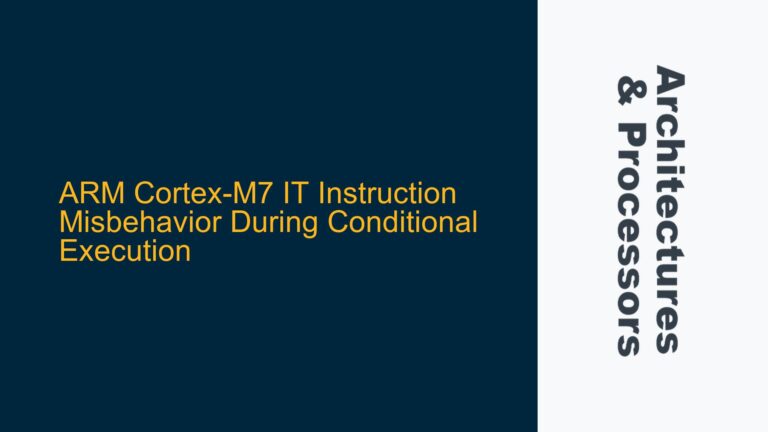SRAM as Flash Substitute in ARM SoC Design
In the context of ARM-based System-on-Chip (SoC) design, the decision to replace flash memory with SRAM is driven by several factors, including process limitations, design complexity, and power management constraints. Flash memory typically requires additional on-chip modules such as DC-to-DC converters and power management control features, which can significantly increase the design complexity and area overhead. In contrast, SRAM is simpler to integrate, especially when using memory compilers that only support SRAM generation. However, this substitution introduces a set of challenges that must be carefully addressed to ensure the SoC functions correctly and efficiently.
The primary issue arises from the fundamental differences between flash memory and SRAM. Flash memory is non-volatile, meaning it retains data even when power is removed, whereas SRAM is volatile and loses its contents upon power loss. This characteristic necessitates a different approach to bootstrapping and code execution. Additionally, the timing, power consumption, and interface protocols for SRAM differ from those of flash memory, which can lead to integration and performance issues if not properly managed.
Memory Volatility and Bootstrapping Challenges
The most immediate challenge when replacing flash memory with SRAM is the volatility of SRAM. In a typical ARM SoC, the boot process involves loading the initial code from non-volatile memory (flash) into volatile memory (SRAM or DRAM) for execution. When SRAM is used in place of flash, the system must be reprogrammed every time it is powered on, as the SRAM will lose its contents. This requires a mechanism to load the code into SRAM before the processor begins execution.
One possible cause of failure in this scenario is the lack of a reliable method to load the initial code into SRAM. If the system relies on an external debugger to program the SRAM, this process must be seamless and error-free. Any delay or failure in loading the code can result in the processor executing invalid or incomplete instructions, leading to system crashes or undefined behavior.
Another potential issue is the timing of the boot process. In a traditional setup, the processor can begin executing code from flash memory almost immediately after power-on. However, when using SRAM, there is an additional step of loading the code, which introduces a delay. This delay must be accounted for in the system’s boot sequence to ensure that the processor does not attempt to execute code before it is fully loaded into SRAM.
Debugger-Based SRAM Programming and Timing Constraints
To address the volatility of SRAM, a common approach is to use an external debugger to program the SRAM with the necessary code each time the system is powered on. This method relies on the debugger’s ability to quickly and accurately load the code into SRAM before the processor begins execution. However, this approach introduces several timing and synchronization challenges that must be carefully managed.
One of the key challenges is ensuring that the debugger can program the SRAM within the required time frame. The time it takes to load the code into SRAM depends on several factors, including the size of the code, the speed of the debug interface, and the bandwidth of the SRAM. If the code is too large or the debug interface is too slow, the processor may start executing before the SRAM is fully programmed, leading to errors.
Another challenge is synchronizing the debugger’s programming process with the processor’s boot sequence. The processor must be held in a reset state while the debugger programs the SRAM, and then released once the programming is complete. This requires precise control over the reset and release signals, as well as a mechanism to detect when the SRAM programming is finished. Any misalignment in this synchronization can result in the processor starting execution too early or too late, both of which can cause system failures.
Implementing a Robust SRAM Initialization and Boot Sequence
To successfully replace flash memory with SRAM in an ARM SoC, a robust initialization and boot sequence must be implemented. This sequence must ensure that the SRAM is correctly programmed before the processor begins execution, and that the processor starts execution at the correct time. The following steps outline a possible solution to this challenge:
First, the system must be designed to hold the processor in a reset state while the debugger programs the SRAM. This can be achieved by using a reset controller that keeps the processor in reset until a signal from the debugger indicates that the SRAM programming is complete. The reset controller should be designed to handle the timing constraints of the debug interface and the SRAM programming process, ensuring that the processor is not released from reset too early.
Second, the debugger must be configured to program the SRAM as quickly and efficiently as possible. This may involve optimizing the debug interface to maximize bandwidth, or using compression techniques to reduce the size of the code being loaded. The debugger should also be capable of detecting and correcting any errors that occur during the programming process, to ensure that the SRAM is correctly programmed before the processor is released from reset.
Third, the system must include a mechanism to verify that the SRAM has been correctly programmed before the processor begins execution. This can be achieved by adding a checksum or CRC check to the code being loaded into SRAM, and having the debugger verify this checksum after programming. If the checksum does not match, the debugger can retry the programming process or alert the user to the error.
Finally, the system must be designed to handle any timing variations that may occur during the SRAM programming process. This may involve adding delays or synchronization points to the boot sequence, to ensure that the processor does not start execution until the SRAM is fully programmed and verified. The system should also be designed to handle any unexpected events, such as power fluctuations or debugger disconnections, that could disrupt the SRAM programming process.
Power Management and SRAM Retention Strategies
Another critical aspect of replacing flash memory with SRAM in an ARM SoC is managing power consumption and ensuring data retention during power cycles. Unlike flash memory, SRAM requires continuous power to retain its contents. This poses a challenge in low-power or battery-operated devices where power consumption must be minimized.
One possible solution is to implement a power management unit (PMU) that can selectively power down different parts of the SoC, including the SRAM, when they are not in use. However, this approach must be carefully designed to ensure that the SRAM is powered up and ready before the processor begins execution. The PMU should be capable of quickly restoring power to the SRAM and ensuring that its contents are valid before the processor is released from reset.
Another strategy is to use a small amount of non-volatile memory, such as a battery-backed SRAM or a small flash memory, to store the initial boot code. This non-volatile memory can be used to bootstrap the system and load the main code into SRAM, reducing the reliance on an external debugger. This approach can also provide a fallback mechanism in case the SRAM programming process fails, allowing the system to recover and retry the boot sequence.
Conclusion
Replacing flash memory with SRAM in an ARM SoC design presents several challenges, including memory volatility, bootstrapping, timing constraints, and power management. However, with careful design and implementation, these challenges can be overcome. By using an external debugger to program the SRAM, implementing a robust initialization and boot sequence, and managing power consumption effectively, it is possible to create a functional and efficient ARM SoC that uses SRAM in place of flash memory. This approach can simplify the design process and reduce the complexity of the SoC, making it a viable option for certain applications.






